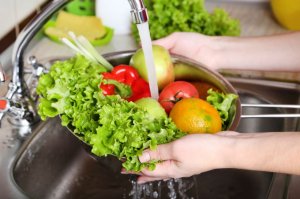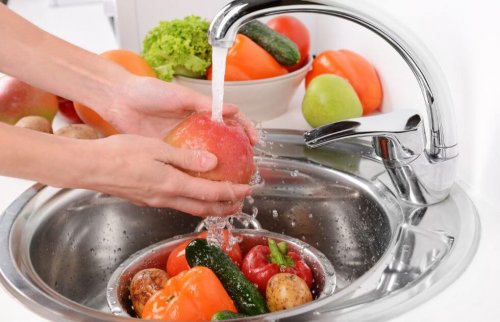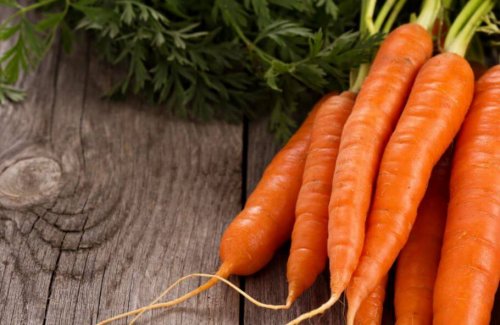Learn How to Properly Wash Fruits and Vegetables

Fruits and vegetables offer us many essential nutrients. However, if we don’t wash them properly, they can become our worst enemies. Washing fruits and vegetables before consuming them is a crucial step in avoiding toxins, germs, and bacteria.
When you have children or elderly members at home, washing food is extremely important. These days, the dangers that food can present also include the traces of agrochemicals. The uncontrolled use of these substances can wreak havoc with our digestive systems.
Why should you wash fruits and vegetables before eating them?
As we mentioned above, some people are at a higher risk of suffering from food poisoning from eating poorly washed produce. Pregnant women, the elderly and children are more prone to suffering from toxoplasmosis. Buying produce that’s sold on the street, for example, can end up being extremely dangerous.

You have to clean fruits and vegetables from pesticides, bacteria, and chemicals that might result from the packaging process. Although the percentage of people who become sick from eating poorly washed produce is minimal, the risk is still there.
Every once in a while, we hear the news that a supermarket has sold products that were contaminated with E. Coli. These events happen because, despite the fact that the produce itself was clean, it was still exposed to contaminating factors in the environment. Fruits and vegetables can be contaminated with salmonella and other bacteria that are present on the farm or on the land.
Thus, you have to wash produce, even organic products, properly. Even though fruits and vegetables may be free of pesticides, they’re still exposed to other factors in the environment.
How can you wash fruits and vegetables properly for consumption?
There’s an old wives’ tip for cleaning fruits and vegetables; you can try this at home. All you need to do is mix water and lemon juice in a cup to make an edible disinfectant. As a variation, you can also replace the lemon juice with vinegar.
You should store fruits and vegetables with an edible peel in the fridge, already cleaned; make sure to keep them separated from meats, eggs, and other foods.
Some examples of how to clean produce
When it comes to washing, lettuces and leeks are special cases; lettuce, because we eat it raw, carries a higher risk of food poisoning. For lettuce, leaving the head to soak in water with lemon juice for 20 minutes can ensure total disinfection. After 20 minutes, rinse the lettuce and wash again.
To make sure that your lettuce is clean, remove the outer leaves. The outer leaves are often more exposed to contaminants and bacteria. This might seem like a minor detail, but it makes all the difference. Removing the outer part of the food is applicable to preparing any other kind of product that comes from the ground.
As for the pre-packaged salads that you can find at supermarkets, they’re generally ready for consumption. You might not have to wash them, but you could always sprinkle them with some drops of lemon juice to clear any lingering germs. It’s a step definitely worth doing for the elderly, pregnant women or children.
Leeks are another type of vegetable that can be quite difficult to wash properly. Some notable nutritionists and chefs simply choose to cut leeks in half before cleaning them. By cutting them in half, water can reach every space within the leek. After cutting it, you should let it soak, just as you would do for other leafy greens.

What could happen if I don’t wash my produce before eating it?
The cases of food poisoning that can result from consuming poorly washed produce aren’t normally serious. In cases of toxoplasmosis, symptoms rarely amount to anything more than you would experience with the flu: headaches, fever, and weakness. You should never eat contaminated produce during pregnancy, as it could have serious repercussions for the baby.
In any case, once the body consumes the toxic agent, it immunizes itself against toxoplasmosis. As a result, the chances of getting sick again reduce considerably.
Eating contaminated fruits and vegetables can lead to other conditions as well. Some of these include typhoid, salmonella, gastroenteritis, diarrhea, amebiasis, stomach pain, and other problems.
Fruits and vegetables offer us many essential nutrients. However, if we don’t wash them properly, they can become our worst enemies. Washing fruits and vegetables before consuming them is a crucial step in avoiding toxins, germs, and bacteria.
When you have children or elderly members at home, washing food is extremely important. These days, the dangers that food can present also include the traces of agrochemicals. The uncontrolled use of these substances can wreak havoc with our digestive systems.
Why should you wash fruits and vegetables before eating them?
As we mentioned above, some people are at a higher risk of suffering from food poisoning from eating poorly washed produce. Pregnant women, the elderly and children are more prone to suffering from toxoplasmosis. Buying produce that’s sold on the street, for example, can end up being extremely dangerous.

You have to clean fruits and vegetables from pesticides, bacteria, and chemicals that might result from the packaging process. Although the percentage of people who become sick from eating poorly washed produce is minimal, the risk is still there.
Every once in a while, we hear the news that a supermarket has sold products that were contaminated with E. Coli. These events happen because, despite the fact that the produce itself was clean, it was still exposed to contaminating factors in the environment. Fruits and vegetables can be contaminated with salmonella and other bacteria that are present on the farm or on the land.
Thus, you have to wash produce, even organic products, properly. Even though fruits and vegetables may be free of pesticides, they’re still exposed to other factors in the environment.
How can you wash fruits and vegetables properly for consumption?
There’s an old wives’ tip for cleaning fruits and vegetables; you can try this at home. All you need to do is mix water and lemon juice in a cup to make an edible disinfectant. As a variation, you can also replace the lemon juice with vinegar.
You should store fruits and vegetables with an edible peel in the fridge, already cleaned; make sure to keep them separated from meats, eggs, and other foods.
Some examples of how to clean produce
When it comes to washing, lettuces and leeks are special cases; lettuce, because we eat it raw, carries a higher risk of food poisoning. For lettuce, leaving the head to soak in water with lemon juice for 20 minutes can ensure total disinfection. After 20 minutes, rinse the lettuce and wash again.
To make sure that your lettuce is clean, remove the outer leaves. The outer leaves are often more exposed to contaminants and bacteria. This might seem like a minor detail, but it makes all the difference. Removing the outer part of the food is applicable to preparing any other kind of product that comes from the ground.
As for the pre-packaged salads that you can find at supermarkets, they’re generally ready for consumption. You might not have to wash them, but you could always sprinkle them with some drops of lemon juice to clear any lingering germs. It’s a step definitely worth doing for the elderly, pregnant women or children.
Leeks are another type of vegetable that can be quite difficult to wash properly. Some notable nutritionists and chefs simply choose to cut leeks in half before cleaning them. By cutting them in half, water can reach every space within the leek. After cutting it, you should let it soak, just as you would do for other leafy greens.

What could happen if I don’t wash my produce before eating it?
The cases of food poisoning that can result from consuming poorly washed produce aren’t normally serious. In cases of toxoplasmosis, symptoms rarely amount to anything more than you would experience with the flu: headaches, fever, and weakness. You should never eat contaminated produce during pregnancy, as it could have serious repercussions for the baby.
In any case, once the body consumes the toxic agent, it immunizes itself against toxoplasmosis. As a result, the chances of getting sick again reduce considerably.
Eating contaminated fruits and vegetables can lead to other conditions as well. Some of these include typhoid, salmonella, gastroenteritis, diarrhea, amebiasis, stomach pain, and other problems.
This text is provided for informational purposes only and does not replace consultation with a professional. If in doubt, consult your specialist.








